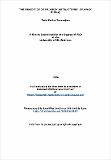Files in this item
The semiotics of printed instructions (graphic signa)
Item metadata
| dc.contributor.advisor | Hervey, Sandor | |
| dc.contributor.author | Toumajian, Trak-Sarkis | |
| dc.coverage.spatial | 354 | en_US |
| dc.date.accessioned | 2012-07-02T15:44:01Z | |
| dc.date.available | 2012-07-02T15:44:01Z | |
| dc.date.issued | 1986 | |
| dc.identifier.uri | https://hdl.handle.net/10023/2899 | |
| dc.description.abstract | This thesis sets out to describe sign systems for communication using Axiomatic Functionalism as its theoretical framework. In doing so, the thesis also provides an important test to the claim of Axiomatic Functionalism that by using its premisses the semiotician (or linguist) has all the necessary "tools" s/he needs for the analysis and description (the one implies the other) of any semiotic system for communication (including Language). Using Axiomatic Functionalism the author attempts to describe a number of graphic semiotic systems for communication. He finds that for an adequate description of the signa (a generic term which includes various types of signs and symbols) in these systems further theoretical notions and definitions are needed. Discussing these the author concludes that for Axiomatic Functionalism to maintain its claim of universal applicability to any sign system for communication it needs to incorporate in its premisses the notions and definitions proposed here. The thesis begins by a brief general introduction to semiotics. This is followed by a discussion of what constitutes scientific theories in relation to semiotics (including linguistics). The relevant aspects of Axiomatic Functionalism are then discussed, after which certain original theoretical notions are introduced. These include: “mnemonic economy" (with its many manifestations including "mnemonic/pictorial motivation"), the "general organising principle" ("systemic principle"), "principle of coinage" (a mechanism for generating signa), and "signum-family”. Having established the necessary theoretical background, the author proceeds to describe various graphic “signum-systems" discussing their important features and establishing the types of signum they consist of and, consequently, the types of system they are, their complexity and the "plerology” (grammar) of each system, where present. The systems discussed include various systems used in books on plants; a system used in a book on "lace knitting"; a system used in working models; a system used in providing information about paintings in the "Classics of World Art" series of books; and a system used in the "Automobile Association" handbooks. Further Axiomatic Functionalist theoretical notions, directly relevant to the systems described thereafter, are then introduced. This is followed by a description of three systems: two computer "languages", the "Hexadecimal notation" and the "binary code", and the "Library of Congress classification system". A final brief "Epilogue" concludes the thesis. | en_US |
| dc.language.iso | en | en_US |
| dc.subject.lcc | P325.T7 | |
| dc.subject.lcsh | Semantics | en_US |
| dc.subject.lcsh | Semiotics | en_US |
| dc.title | The semiotics of printed instructions (graphic signa) | en_US |
| dc.type | Thesis | en_US |
| dc.type.qualificationlevel | Doctoral | en_US |
| dc.type.qualificationname | PhD Doctor of Philosophy | en_US |
| dc.publisher.institution | The University of St Andrews | en_US |
This item appears in the following Collection(s)
Items in the St Andrews Research Repository are protected by copyright, with all rights reserved, unless otherwise indicated.

